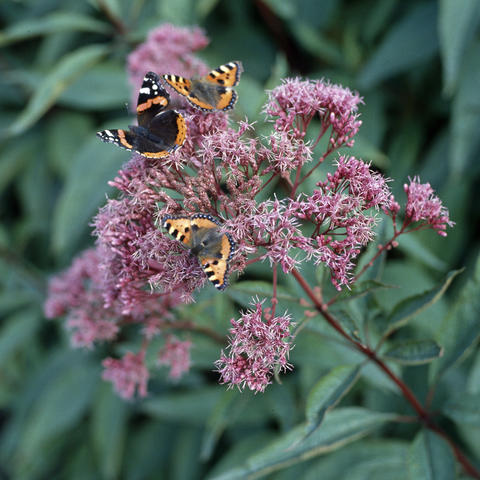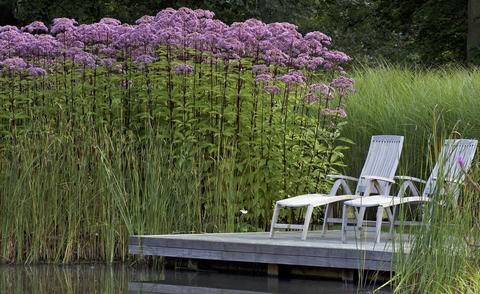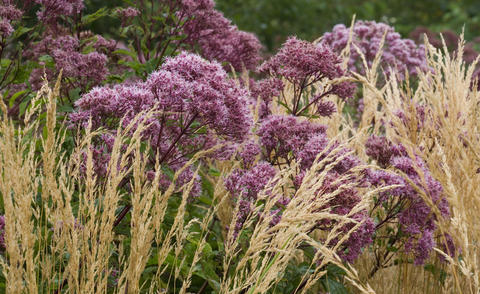Purple Joe-Pye Weed
A low-maintenance voracious flowerer: purple Joe-Pye weed (Eupatorium purpureum) flowers into fall and is one of the most attractive wild perennials thanks to its large, purple-red flowers.
Factsheet
- Growth type
-
- Perennial plant
- Growth height (from)
- from 120 cm to 200 cm
- Growth width (from)
- from 60 cm to 100 cm
- Growth characteristics
-
- upright
- horst-forming
- Flower color
-
- red
- pink
- Flowering time (month)
-
- July to September
- Flower shape
-
- Flowercups
- Umbelliferous panicles
- tubular
- Flower characteristics
-
- lightly fragrant
- Leaf color
-
- green
- page format
-
- sawn
- lancéolées
- Fruit characteristics
-
- Self-seeding
- Light
-
- sunny to semi-shade
- Soil type
-
- stony
- loamy to clayey
- Soil Moisture
-
- fresh to humid
- ph value
-
- weakly alkaline to weakly acidic
- Nutrient requirements
-
- nutrient-rich
- Humus
-
- rich in humus
- Decorative or utility value
-
- Flower Decoration
- Winter Hardness
-
- hardy
- Climate zones according to USDA
-
- 5
- areas of life
-
- GR2
- GR3
- FR3
- Use
-
- Bouquets
- Group planting
- Planters
- privacy screen
- Pond planting
- Rebates
- Garden style
-
- Flower garden
- natural garden
- Water garden
- Bee Friendly
- bee friendly plant
Purple Joe-Pye weed, also known as sweet Joe-Pye weed or kidney root, is part of the sunflower family (Asteraceae) and is a very decorative, large wild perennial that is also used in plant medicine. This type of Eupatorium, or boneset, is native to North America, where it is predominantly widespread in the eastern half of the continent. It is found in slightly damp soils in thickets and forests as well as near water. Even in Europe, Eupatorium purpureum does best in fresh to moist locations, and is ideally suited to use as a lovely decorative addition to the edges of woodland or ponds. In any case, this perennial, with its bushy, tall growth as well as its majestic purple-pink flowers, will surely add a natural charm wherever it’s planted. Just like Eupatorium cannabinum, or hemp-agrimony, it’s also a favorite among insects: butterflies in particular but also bees and bumblebees enjoy bustling around these colorful, delicately scented arrays of flowers, creating plenty of hustle and bustle in the garden.
Eupatorium purpureum is a tuft-forming perennial that can grow up to 3.9 to 6.5 feet tall. Its growth is lush, upright and between 2 and 3.2 feet wide. Sweet Joe-Pye weed’s strong stems feature a blue-green to brown-purple color.
Purple Joe-Pye weed’s green, lanceolate leaves grow up to 12 inches long and feature serration along the edges. They have short stalks and are arranged in whorls around the plant’s stems in threes or fours. This perennial is deciduous, so loses its leaves in fall.
Purple Joe-Pye weed flowers from June to September in a beautiful shade of pink to purple-red and gives off a delicate scent not unlike vanilla. Its small flower heads consists of just a few individual tubular flowers. These heads sit in broad, umbellate panicles, forming large flowering semi-spheres.

In fall, thin seeds appear on sweet Joe-Pye weed’s wilted flower heads. These feature fine hairs that help the wind distribute them easily.
Purple Joe-Pye weed thrives best in sunny to partially shaded locations. As well as along the edges of woodland and ponds, open spaces are also suitable for planting this perennial. Good water supply is essential in sunny locations.
Eupatorium purpureum requires fresh to moist, nutrient-rich, deep and humus-rich soil to grow well. Stoney to loamy-clay substrate is particularly suitable for this wild perennial. The pH should be weakly alkaline to weakly acidic.
Ideally, purple Joe-Pye weed should be planted in the garden in spring - either individually or in small groups of two to three plants. Due to their wide growth, a distance of around 2.6 to 3.3 feet should be left between the plants. As they grow pretty large, these wild perennials are ideal as a background for your bed. Eupatorium purpureum even thrives in pots but will not grow quite so large or flower so much.
Purple Joe-Pye weed is actually a very low-maintenance perennial. Make sure that the location is always fresh to moist and the soil never dries out completely. Water moderately so that the water soaks into deeper soil layers. It’s especially important in sunny locations and in hot summers to ensure an optimal, even water supply. If you don’t want these plants to self-seed, remove the flowers in fall and cut the plant back to ground level. The wilted flower heads make a charming decorative feature in a winter garden though - especially when covered in tiny frost crystals or fine powder snow. If left, cut your purple Joe-Pye weed back to ground level in spring.

If Eupatorium purpureum grows in low-nutrient soil, it can be rejuvenated every couple years through division. This ensures a boost in growth and abundant flowers. To do so, dig up all around the purple Joe-Pye weed root ball in spring before it begins to grow new shoots. Remove any infected or dry roots and separate the ball with a sharp spade into pieces at least around fist size. The best thing? This division also propagates this perennial.
Purple Joe-Pye weed is winter hardy and will even withstand frost without special protection.
Sweet Joe-Pye weed really comes into its own in a natural environment: with its large, purple-red flowers, it provides a pop of color around garden ponds, in open spaces and along the edge of woodland in summer and through into fall. Its tall height makes it ideal as a privacy screen too. Eupatorium purpureum is perfect for combining with other perennials with long flowering periods, such as spiderwort with its purple flowers or purple loosestrife with its dark pink blooms. The yellow flowers of the heartleaf oxeye (Telekia speciosa) or tall coreopsis (Coreopsis tripteris) make for a particularly impressive juxtaposition of color. In a suitable location, purple Joe-Pye weed can take the lead in borders and really stand out among arctic daisies and day lilies. This wild perennial also looks great when combined with tall grasses. The cute flowers of the Eupatorium purpureum are also wonderful for arranging in bouquets.

Eupatorium purpureum varieties “Gateway” and “Purple Bush” promise a more intense color to their flowers.
Purple Joe-Pye weed can be divided in early spring to propagate. New plants can also be easily grown from cuttings. This perennial also self-seeds as long as deadheads containing seeds are not removed.
If Eupatorium purpureum is too dry, powdery mildew can become a problem. This fungal infection presents as a powdery, white coating, mostly affecting the tops of the leaves first before spreading to the undersides and then the rest of the above-ground parts of the plant. If you spot a powdery mildew infection, act fast: remove all affected parts of the plant as quickly as possible and dispose of them with general household waste.

